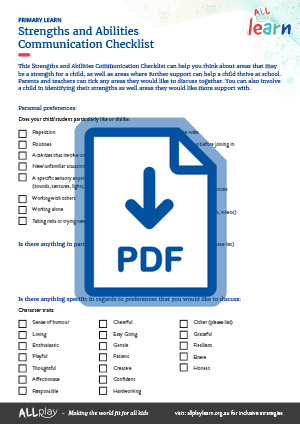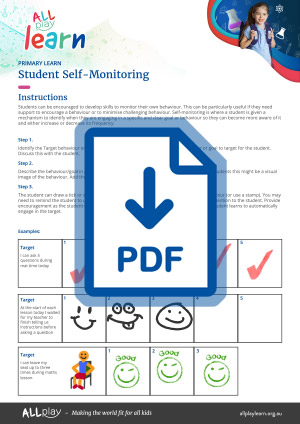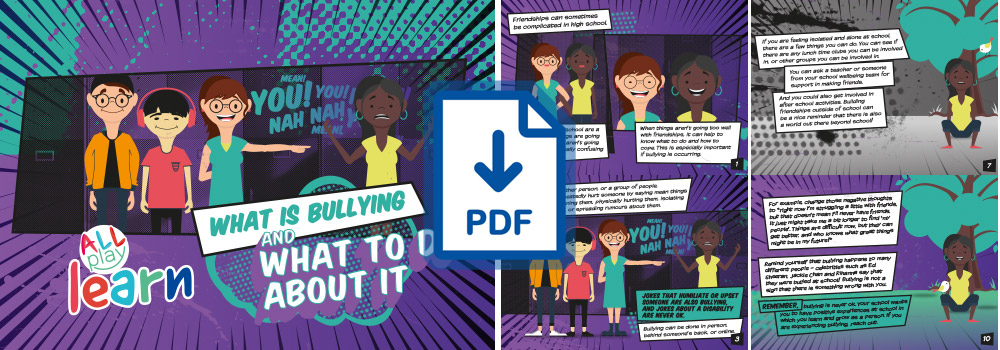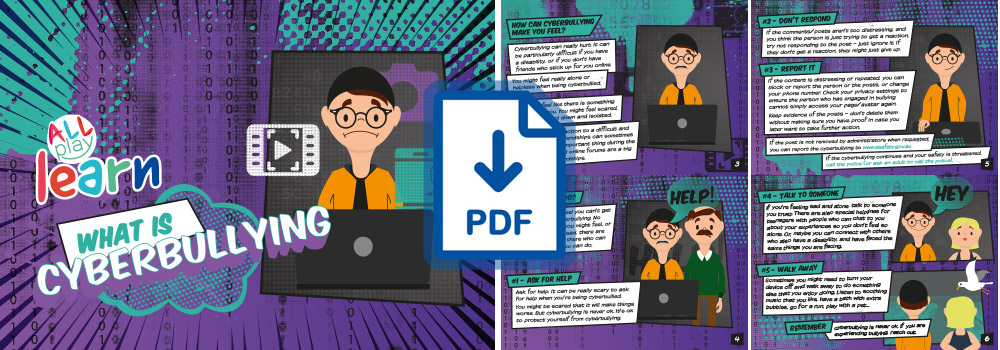
Speech, Language and Communication Needs
On this page:

About speech, language and communication needs
‘Communication’ is the exchange of both verbal and nonverbal information. It includes talking, as well as the understanding of words, visual information, body language, facial expressions, and gestures (e.g. pointing, waving hello, nodding your head to mean “yes”).
Some students may need support with communication. Each young person will have their own profile which may change over time. Some young people may have difficulty producing sounds and words (e.g. stuttering or mutism), and they may use visual forms of communication instead (e.g. gestures, picture cards, or Augmentative or Alternative Communication (AAC) systems or devices). Other students may find understanding visual communication challenging.
Some teens may need support with using and understanding spoken language. A student’s ability to understand spoken language may be different from their ability to use spoken language. For example, a student might be able talk and express themselves clearly, but they may find it harder to understand instructions, especially if they are long or complex.
Some students may require support with using verbal and nonverbal communication in social situations. For example, some students may have trouble with greetings (e.g. saying hello, shaking hands) or taking turns in conversations. Other students may not understand humour and jokes, or metaphors.

Strengths
What might be some strengths?
- Students can often participate successfully in learning when given extra time and clear and specific instructions.
- Some students may have good visual perceptual skills. They may be good at visual searches and recognition.
Where might you provide support?
- Some students with communication needs may have difficulty understanding or talking about abstract information (e.g. a figure of speech, or facts about objects that cannot be seen or touched).
- Some young people with communication challenges may have trouble expressing how they feel. This can cause frustration and disruptive behaviours. They may have other behavioural challenges such as impulsivity and hyperactivity.
- Some students may be easily distracted and find it challenging to focus on activities.
- Students with communication needs may have difficulties with interacting with other students and making friends.

Evidence-based strategies
Work collaboratively
Consider how you give instructions and communicate
Teach students learning strategies
Be patient
- Get more information. Talk to the student, their family and support team to find the best methods of communication and support. They can help you understand the student’s unique strengths and the areas they need more help in. Students can also alert you to their preferences and other challenges they face or might come across.
- Build a relationship with the young person’s other teachers and other professionals involved. Working together can lead to a shared understanding of the student and consistent goals and strategies used across subjects, school and other environments like home and the community.
- Give simple, specific and direct instructions. Check that instructions are explicit, rather than inferred. This might allow the student to be clear about the learning tasks. It can also help to demonstrate/model the task or behaviour, or ask another student to demonstrate.
- Think about the language you use. Students with communication disorders may have trouble understanding complex and lengthy sentence structures. Consider breaking down verbal instructions and information into smaller sections. It may be helpful to check with the student frequently whether there were words they did not understand.
- Use various methods of communication. Visual aids, such as picture cards, can be used in addition to verbal instructions to show a task sequence or a key learning concept. Other options include mind maps to organise visual information, or captioned videos to teach a skill. When providing written instruction, break down large chunks of information into smaller, visually distinct sections. Try to keep questions on the same page as the text.
- Repeat and rephrase instructions. Students may need multiple opportunities to understand instructions. It may be helpful to repeat instructions. If a student has trouble understanding, consider different and simpler ways to present information instead of repeating information in the same way.
- Provide frequent reminders. Verbal and physical prompts can help keep students on-track with learning tasks.
- Teach students how to create their own learning material. Learning how to take notes and create graphic organisers can help students understand and make connections between main points.
- Encourage verbal rehearsal. This can be through repeating information mentally or out aloud.
- Provide plenty of time for students to process information and respond. Try not to rush or interrupt a student when they are trying to speak or communicate. Instead, allow extra time for them to speak and respond. Provide calm and supportive communication to a student.

Best practice tips
Set clear rules and expectations
Consider using slower speech
Ensure that you have the student’s full attention before communicating
Remove distractions
Encourage full participation
Be aware of your body language
Encourage positive role-models
Facilitate the use of AAC systems
Teach social skills
Promote self-determination
- This will allow the student to know what is expected from them at school.
- This can help a student listen to and process instructions.
- This can be done with a gesture, touch, facing the class when providing information, holding eye contact, or using verbal prompts. This may be particularly helpful before giving instructions or speaking to them.
- Students with communication disorders might be easily distracted by lights, sounds and objects both inside and outside the classroom environment. Consider sitting the student away from, or with their back to, the windows. Small group work may also help with reducing distractions, as may keeping desks uncluttered.
- Consider how students can be actively present and engaged in an activity instead of simply watching or listening. This can help build friendships as well as allowing a student to learn new concepts, ideas and behaviours from other students. Some activities that allow for active engagement include role playing, small group work, or activities such as making a poster or chart of the key concept being taught.
- Open, friendly and supportive facial expressions, body postures and tone of voice can support a positive teacher-student relationship.
- Encouraging other students for positive behaviours (e.g. hands up before speaking) helps a student to see what is expected. This may encourage them to imitate these behaviours.
- Unaided AAC systems (e.g., signing, vocalisation, facial expressions) and low-tech AAC systems (e.g., picture communication boards and books, visual schedules) can be beneficial in helping students express themselves.
- Make sure that the environment is arranged to facilitate student’s communication with these systems. For example, check that the AAC system is placed where students can see and access.
- Add key vocabulary to their AAC system specific to your curriculum (where appropriate). For example, vocabulary related a new topic could be introduced.
- You might also consider additional training on using the relevant AAC systems and collaboration with other professionals and families.
- Building the social skills of students can facilitate their communicative participation. For example, you might teach students to consider other people’s feelings, be kind, and share.
- Similarly, teaching students conversational skills, such as asking questions and sharing important information, can facilitate their social interaction with others.
- Promote self-determination. Empower and teach students to make simple choices, set goals, be independent, and develop problem-solving abilities.
- Use technology as needed. For example, technology can be used by students to indicate preference.

Curriculum considerations
- Some students with communication needs may be easily distracted and overwhelmed by various materials and sounds. Consider how the environment can be set up to reduce this.
- Some students with communication needs may need extra support with reading and writing. Consider spending more time explaining new tasks so that students have plenty of opportunities to learn.
- It may be helpful to provide the student with a small list of words they may come across in a book reading or English topic. Consider providing this list in advance so they have time to learn them, and talk with them about any words they are unsure of.
- Consider communicating using various methods when teaching literacy skills. For example, pictures that outline a plot twist may help.
- Provide explicit instructions with clear explanations, modelling and visual supports. For example, help students identify and analyse how ideas and topics are organised in text, using icon cards or pictures as needed, to help with their comprehension. This can also be done to teach grammatical rules and syntax.
- Consider using a phonological -semantic approach when teaching new words. This involves providing phonological instruction alongside instruction to teach the meaning of words.
- Consider identifying what the student needs help with. For more specific strategies for literacy, refer to tips for teaching students with a specific learning disability.
- See Consider how you give instructions and communicate, and Teach students learning strategies.
- Consider pairing the student with another student who can guide and support them during activities.
- Clear rules and expectations can be helpful.
- Consider giving the student active roles to encourage participation.
- Consider how you can reduce the amount of instruction given at a time. It may be helpful to present instructions 2-3 steps at a time so that students can easily follow.
- Repeating instructions helps students process and understand what is being said.
- Consider how you give instructions and communicate.
- Consider how you give instructions and communicate.
- Some students with communication needs may benefit from additional relevant and concise web-based resources and games.
- Promote active involvement through small group activities and role-plays.
- Assess whether learning a language will be of advantage to students, on a case-by-case basis.
- If they are learning a language, focus on areas of strength and build from there.
- Some students might need more time and multiple repetitions.
- Work collaboratively.
- Some students may find maths questions that use words challenging (e.g. Jenny was given a fifteen percent discount on a shirt). Some may have difficulty remembering mathematical patterns (such as patterns in times tables). They might also have trouble understanding mathematical quantities (e.g. greater than or less than).
- Consider using simple words for maths questions and reducing the amount of written material within a question.
- Emphasise understanding and discussion of concepts, as compared to rote learning.
- Use multiple modes to teach key concepts. For example, use concrete visual aids such as abacuses and tiles at the beginning. Later use less concrete modalities such as cards with dots or tally marks. As students become more proficient, introduce abstract representations, such as digits
- Consider how you give instructions and communicate.
- Consider allowing more time to learn skills and understand concepts. It may be helpful to break down key learning concepts and activities into smaller but challenging sequences, or to start with basic concepts before moving on to more complex ones.
- Visual aids such as picture cards, flip charts or posters that students can refer to quickly and easily, may be helpful. Graphic organisers can help students understand the questions being asked, organise their thoughts, and visualise mathematical patterns.
- Some students may find abstract scientific concepts challenging. They may also take some metaphors literally. Hands-on activities that use multiple senses (e.g. touch and smell) may support a student’s learning.
- Consider pairing the student with another student to give guidance and support. Rotating partners can provide opportunities for a student to develop a range of friendships with others.
- It may be helpful to provide the student with a small list of words they may come across in science. Consider providing this list in advance so they have time to learn them, and talk with them about any words they are unsure of.
- It can be helpful to check in with the student to see if they understand key learning concepts and terms, and what they need to do.
- Consider allowing more time for students to complete tasks.
- Some students might benefit from computer software or modified keyboards.

Other considerations
- Some students may not know how to tell an adult if there is an emergency, or what to do in an emergency. Consider making time to demonstrate and practise what to do, or provide them with a non-verbal or simple way to communicate an emergency.
- Role plays can help students learn safety behaviours.
- Some students might show challenging behaviours. It’s important to remember children are most likely trying to communicate a need or want that is not being met.
- Opportunities for students to reflect on their behaviour may be helpful. Consider having face-to-face discussions to check student understanding of expectations of behaviour. It may help to ask students to record their own behaviour. Access AllPlay Learn’s self-monitoring form under relevant resources below.
- Consider providing the student with age-appropriate stories about social situations that they may come across at school. This might help them learn expected behaviours and classroom routines.
- Refer to the ABC approach for more information on how to reduce challenging behaviour by supporting the young person and promoting more helpful behaviour, and our emotions page for more information about supporting a young person with managing their emotions.
- Encouraging team work and giving the student active and important roles in activities can create a sense of belonging and acceptance. Focus on a student’s strengths and avoid drawing attention to their challenges (e.g. asking a student who stutters to repeat themselves multiple times).
- Some students with communication disorders may not be aware of the social cues that indicate that bullying is happening (e.g. mean comments), or may not know how to communicate that they are being bullied. It may help to check in with the student and ask questions about their friendships.
- Consider using role-play in the classroom to highlight how students can identify bullying, and how they can address it. Access AllPlay Learn's teacher guide to bullying and exclusion
- See Teach social skills.
- Access AllPlay Learn’s bullying and cyberbulling stories in relevant resources below
- Simple and concise language in assessments may allow a student better opportunities to demonstrate their understanding of content. Consider talking to students about the meaning of words typically used in assessment tasks (e.g. explain, discuss, compare).
- Consider breaking down large amounts of written material into smaller components.
- In addition to written material, visual aids such as graphs, charts, pictures and icons may help the student have a better understanding of the information being presented.
- Some students may need more time to complete their assessment tasks or might need fewer tasks in the given time.
- Consider providing opportunities for students to demonstrate their learning in different ways (e.g. using posters/models, or video clips)
- Consider working collaboratively with the student’s parents and health professionals to identify strategies that might help support the student in this area.
- For more information about supporting students with disabilities when transitioning to a secondary school setting access AllPlay Learn's transition page.
- Speech, language and communication needs can often co-occur with other developmental delays such as autism, intellectual disability, and specific learning disability. They can also co-occur in students who experience d/Deaf and hard of hearing, or blind or low vision.

Relevant resources
Visit our resources page for a range of resources that can help to create inclusive education environments for students with disabilities and developmental challenges. Some particularly relevant resources for students with communication disorders include:




